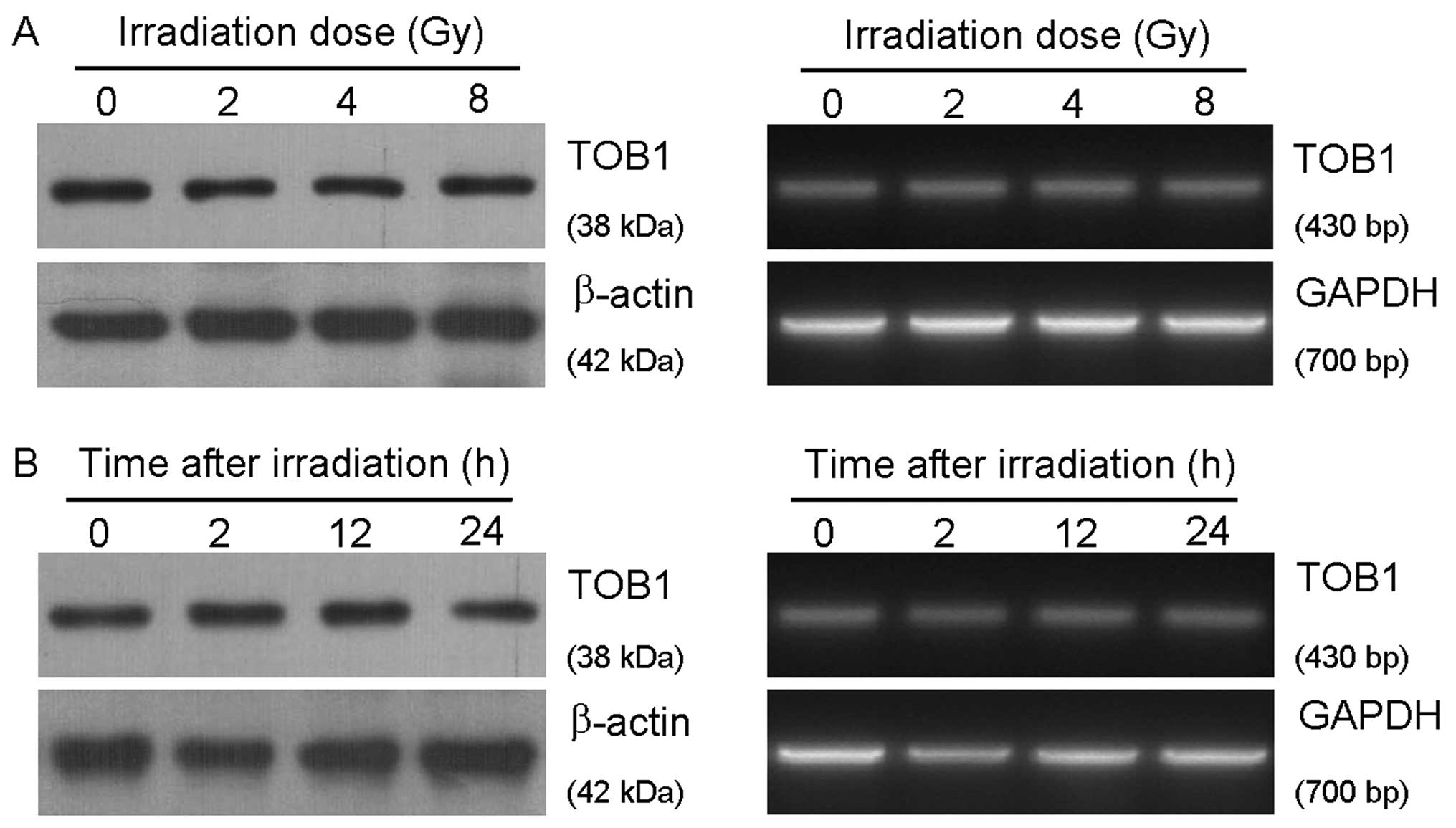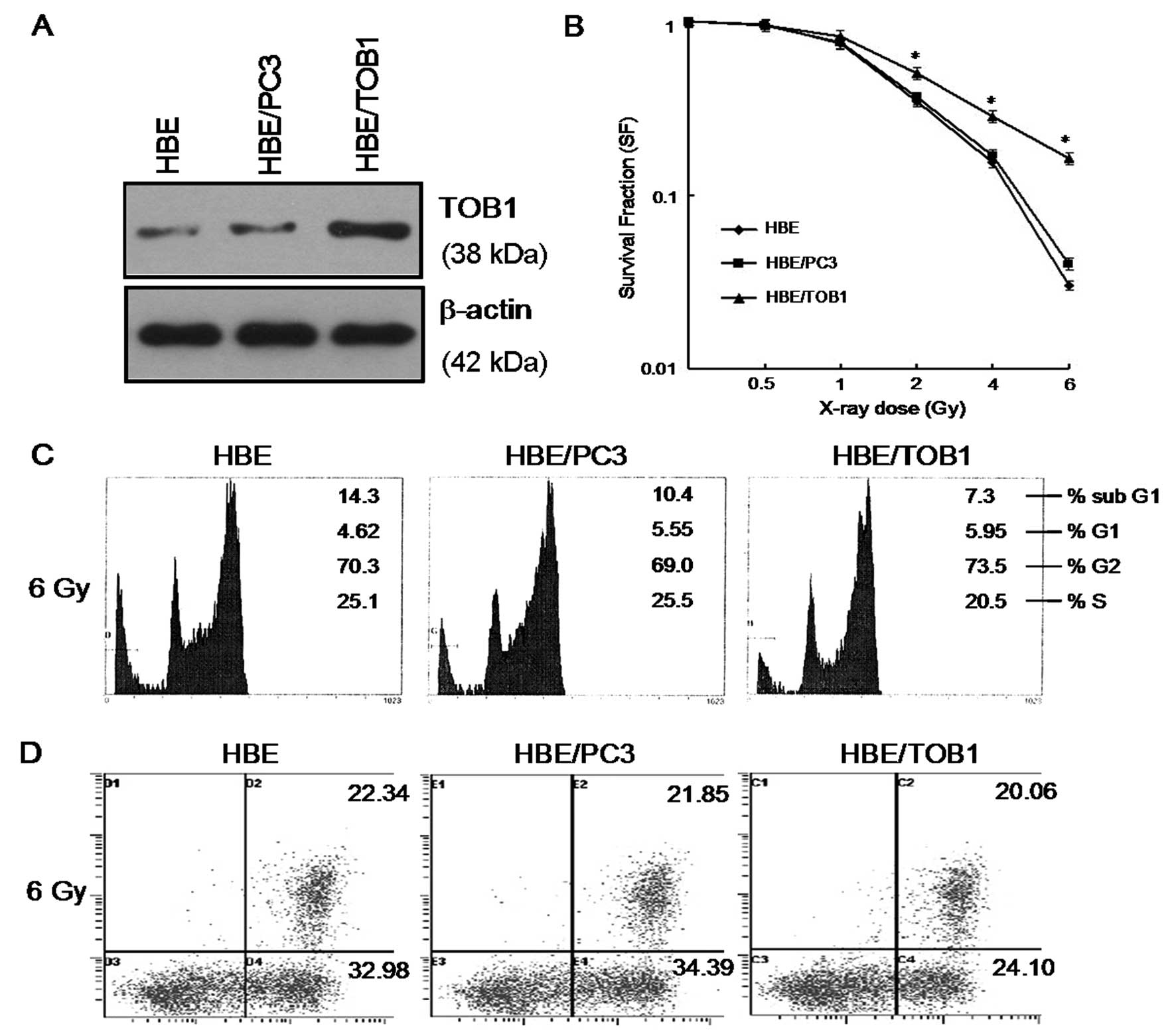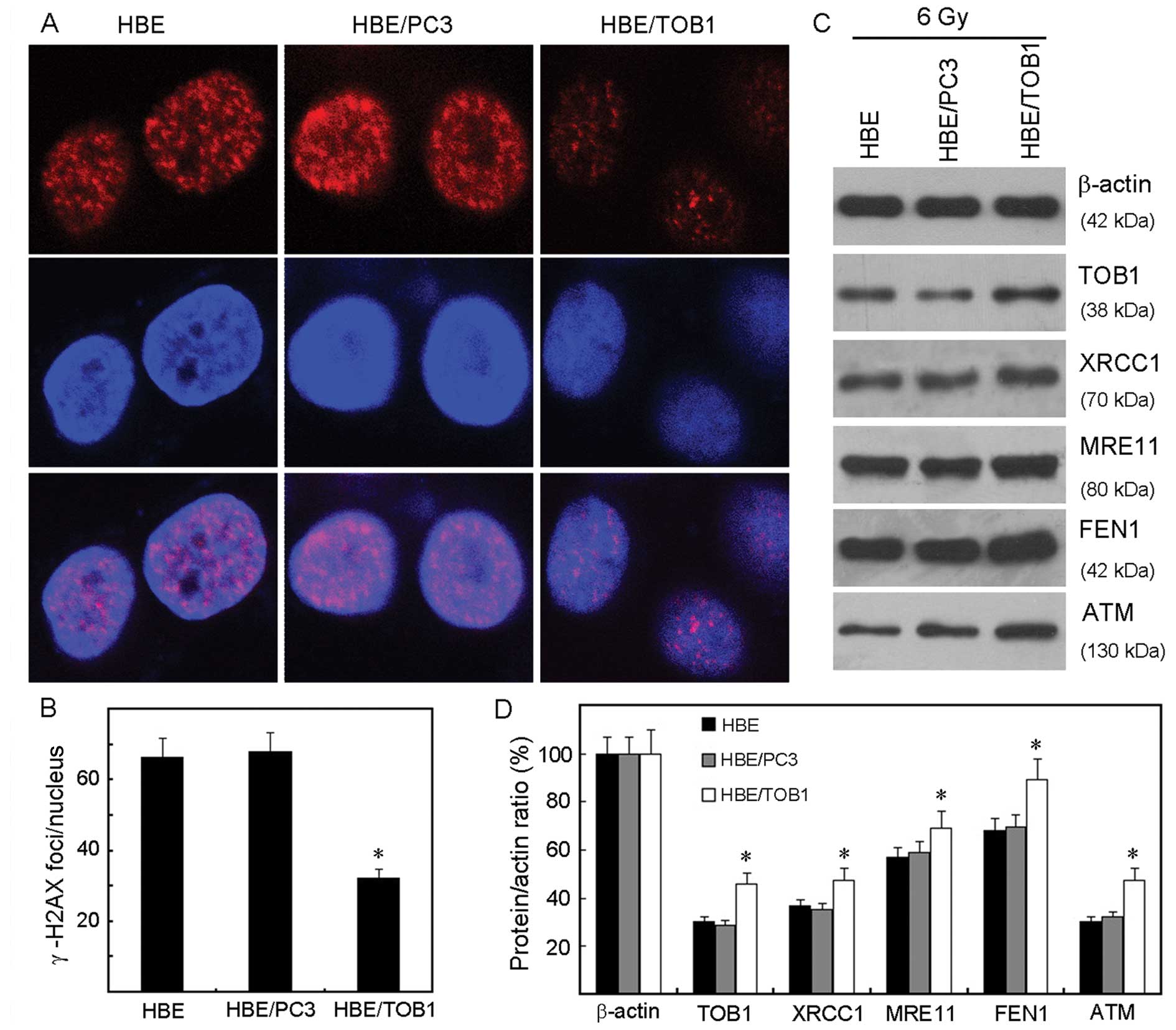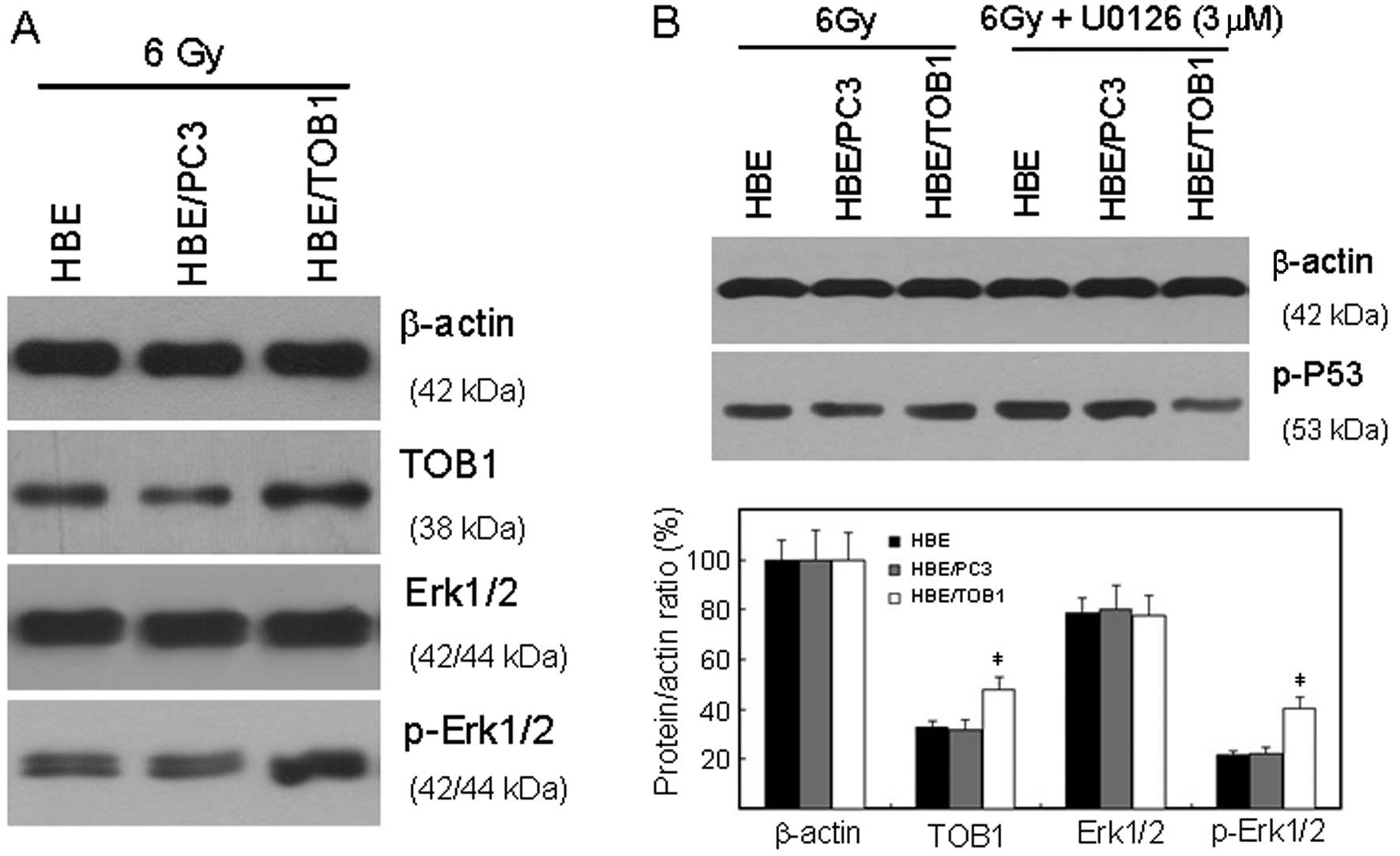|
1
|
Hunter NR, Valdecanas D, Liao Z, Milas L,
Thames HD and Mason KA: Mitigation and treatment of
radiation-induced thoracic injury with a cyclooxygenase-2
inhibitor, celecoxib. Int J Radiat Oncol Biol Phys. 85:472–476.
2012. View Article : Google Scholar : PubMed/NCBI
|
|
2
|
Eldh T, Heinzelmann F, Velalakan A, Budach
W, Belka C and Jendrossek V: Radiation-induced changes in breathing
frequency and lung histology of C57BL/6J mice are time- and
dose-dependent. Strahlenther Onkol. 188:274–281. 2012. View Article : Google Scholar : PubMed/NCBI
|
|
3
|
Ma J, Zhang J, Zhou S, et al: Regional
lung density changes after radiation therapy for tumors in and
around thorax. Int J Radiat Oncol Biol Phys. 76:116–122. 2010.
View Article : Google Scholar : PubMed/NCBI
|
|
4
|
Jia S and Meng A: Tob genes in development
and homeostasis. Dev Dyn. 236:913–921. 2007. View Article : Google Scholar : PubMed/NCBI
|
|
5
|
Yanagie H, Tanabe T, Sumimoto H, et al:
Tumor growth suppression by adenovirus-mediated introduction of a
cell-growth-suppressing gene tob in a pancreatic cancer model.
Biomed Pharmacother. 63:275–286. 2009. View Article : Google Scholar : PubMed/NCBI
|
|
6
|
Tzachanis D and Boussiotis VA: Tob, a
member of the APRO family, regulates immunological quiescence and
tumor suppression. Cell Cycle. 8:1019–1025. 2009. View Article : Google Scholar : PubMed/NCBI
|
|
7
|
Kitagawa K, Kotake Y and Kitagawa M:
Ubiquitin-mediated control of oncogene and tumor suppressor gene
products. Cancer Sci. 100:1374–1381. 2009. View Article : Google Scholar : PubMed/NCBI
|
|
8
|
Helms MW, Kemming D, Contag CH, et al:
TOB1 is regulated by EGF-dependent HER2 and EGFR signaling, is
highly phosphorylated, and indicates poor prognosis in
node-negative breast cancer. Cancer Res. 69:5049–5056. 2009.
View Article : Google Scholar : PubMed/NCBI
|
|
9
|
O’Malley S, Su H, Zhang T, Ng C, Ge H and
Tang CK: TOB suppresses breast cancer tumorigenesis. Int J Cancer.
125:1805–1813. 2009.
|
|
10
|
Jiao Y, Ge CM, Meng QH, Cao JP, Tong J and
Fan SJ: Adenovirus-mediated expression of Tob1 sensitizes breast
cancer cells to ionizing radiation. Acta Pharmacol Sin.
28:1628–1636. 2007. View Article : Google Scholar : PubMed/NCBI
|
|
11
|
Jiao Y, Xu JY, Che J and Fan SJ: Study on
the effects of anti-proliferative protein Tob1 on the
radio-sensitivity of human cervix cancer cell line HeLa. J Radiat
Res Radiat Proc. 28:193–196. 2010.(In Chinese).
|
|
12
|
Jiao Y, Sun KK, Zhao L, Xu JY, Wang LL and
Fan SJ: Suppression of human lung cancer cell proliferation and
metastasis in vitro by the transducer of ErbB-2.1 (TOB1). Acta
Pharmacol Sin. 33:250–260. 2012. View Article : Google Scholar : PubMed/NCBI
|
|
13
|
Gannon HS, Woda BA and Jones SN: ATM
phosphorylation of Mdm2 Ser394 regulates the amplitude and duration
of the DNA damage response in mice. Cancer Cell. 21:668–679. 2012.
View Article : Google Scholar : PubMed/NCBI
|
|
14
|
Guckenberger M, Baier K, Polat B, et al:
Dose-response relationship for radiation-induced pneumonitis after
pulmonary stereotactic body radiotherapy. Radiother Oncol.
97:65–70. 2010. View Article : Google Scholar : PubMed/NCBI
|
|
15
|
Hart JP, McCurdy MR, Ezhil M, et al:
Radiation pneumonitis: correlation of toxicity with pulmonary
metabolic radiation response. Int J Radiat Oncol Biol Phys.
71:967–971. 2008. View Article : Google Scholar : PubMed/NCBI
|
|
16
|
Nokisalmi P, Rajecki M, Pesonen S, et al:
Radiation-induced upregulation of gene expression from adenoviral
vectors mediated by DNA damage repair and regulation. Int J Radiat
Oncol Biol Phys. 83:376–384. 2012. View Article : Google Scholar : PubMed/NCBI
|
|
17
|
Parplys AC, Petermann E, Petersen C,
Dikomey E and Borgmann K: DNA damage by X-rays and their impact on
replication processes. Radiother Oncol. 102:466–471. 2010.
View Article : Google Scholar : PubMed/NCBI
|
|
18
|
Neumaier T, Swenson J, Pham C, et al:
Evidence for formation of DNA repair centers and dose-response
nonlinearity in human cells. Proc Natl Acad Sci USA. 109:443–448.
2012. View Article : Google Scholar : PubMed/NCBI
|
|
19
|
Hlatky L: Double-strand break motions
shift radiation risk notions. Proc Natl Acad Sci USA. 109:351–352.
2012. View Article : Google Scholar : PubMed/NCBI
|
|
20
|
Schneider L, Fumagalli M and d’Adda dFF:
Terminally differentiated astrocytes lack DNA damage response
signaling and are radioresistant but retain DNA repair proficiency.
Cell Death Differ. 19:582–591. 2012. View Article : Google Scholar : PubMed/NCBI
|
|
21
|
Zlobinskaya O, Dollinger G, Michalski D,
et al: Induction and repair of DNA double-strand breaks assessed by
gamma-H2AX foci after irradiation with pulsed or continuous proton
beams. Radiat Environ Biophys. 51:23–32. 2012. View Article : Google Scholar : PubMed/NCBI
|
|
22
|
Khoronenkova SV, Dianova II, Ternette N,
Kessler BM, Parsons JL and Dianov GL: ATM-dependent downregulation
of USP7/HAUSP by PPM1G activates p53 response to DNA damage. Mol
Cell. 45:801–813. 2012. View Article : Google Scholar : PubMed/NCBI
|
|
23
|
Shouse GP, Nobumori Y, Panowicz MJ and Liu
X: ATM-mediated phosphorylation activates the tumor-suppressive
function of B56gamma-PP2A. Oncogene. 30:3755–3765. 2011. View Article : Google Scholar : PubMed/NCBI
|
|
24
|
Cheng Q, Cross B, Li B, Chen L, Li Z and
Chen J: Regulation of MDM2 E3 ligase activity by phosphorylation
after DNA damage. Mol Cell Biol. 31:4951–4963. 2011. View Article : Google Scholar : PubMed/NCBI
|
|
25
|
Gajjar M, Candeias MM, Malbert-Colas L, et
al: The p53 mRNA-Mdm2 interaction controls Mdm2 nuclear trafficking
and is required for p53 activation following DNA damage. Cancer
Cell. 21:25–35. 2012. View Article : Google Scholar : PubMed/NCBI
|
|
26
|
Chiu YJ, Hour MJ, Lu CC, et al: Novel
quinazoline HMJ-30 induces U-2 OS human osteogenic sarcoma cell
apoptosis through induction of oxidative stress and up-regulation
of ATM/p53 signaling pathway. J Orthop Res. 29:1448–1456. 2011.
View Article : Google Scholar : PubMed/NCBI
|
|
27
|
Yang Y, Xia F, Hermance N, et al: A
cytosolic ATM/NEMO/RIP1 complex recruits TAK1 to mediate the
NF-kappaB and p38 mitogen-activated protein kinase
(MAPK)/MAPK-activated protein 2 responses to DNA damage. Mol Cell
Biol. 31:2774–2786. 2011. View Article : Google Scholar : PubMed/NCBI
|
|
28
|
Rutkowski R, Dickinson R, Stewart G, et
al: Regulation of Caenorhabditis elegans p53/CEP-1-dependent
germ cell apoptosis by Ras/MAPK signaling. PLoS Genet.
7:e10022382011.PubMed/NCBI
|


















